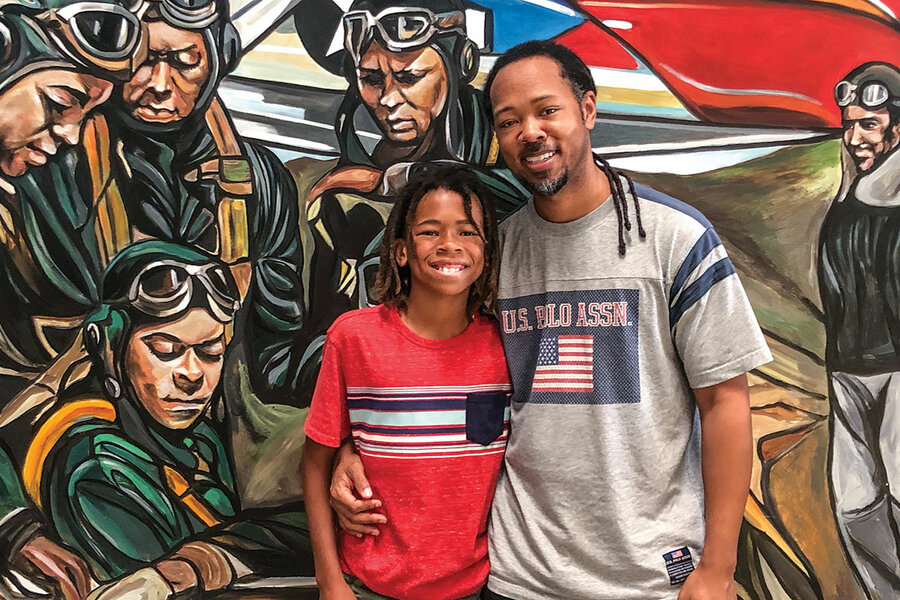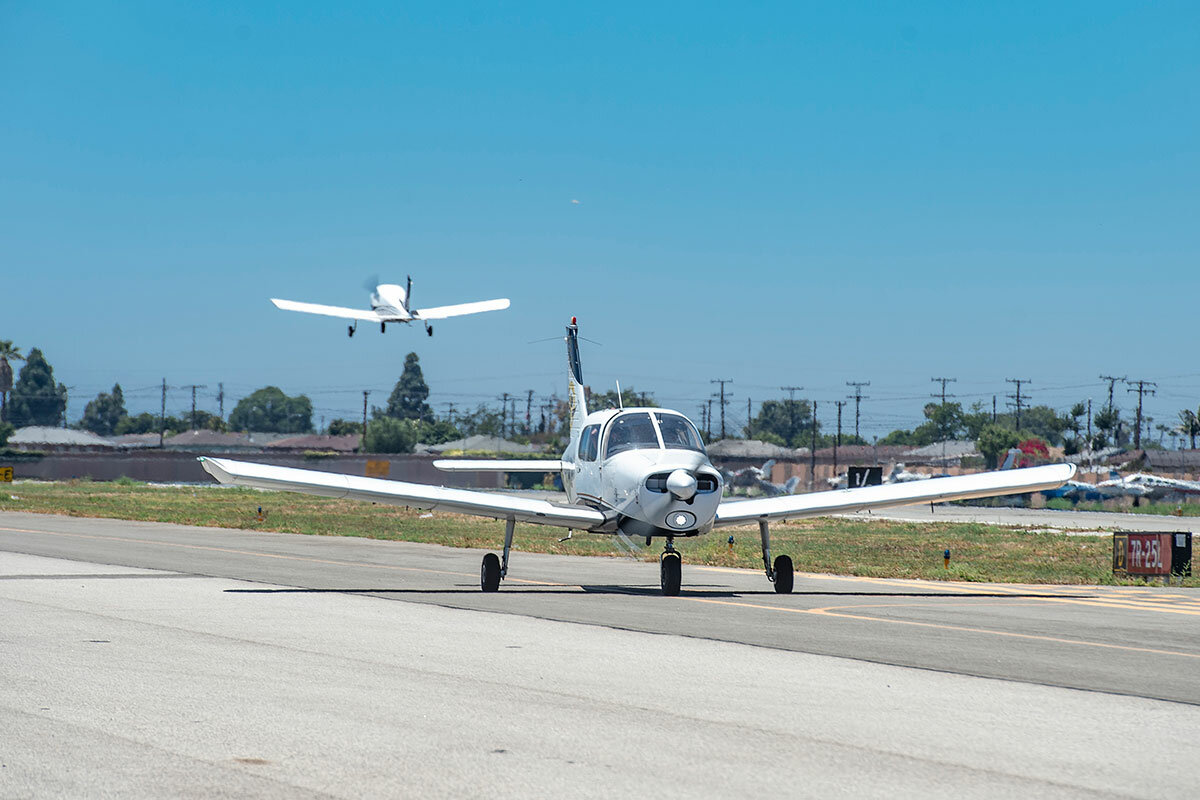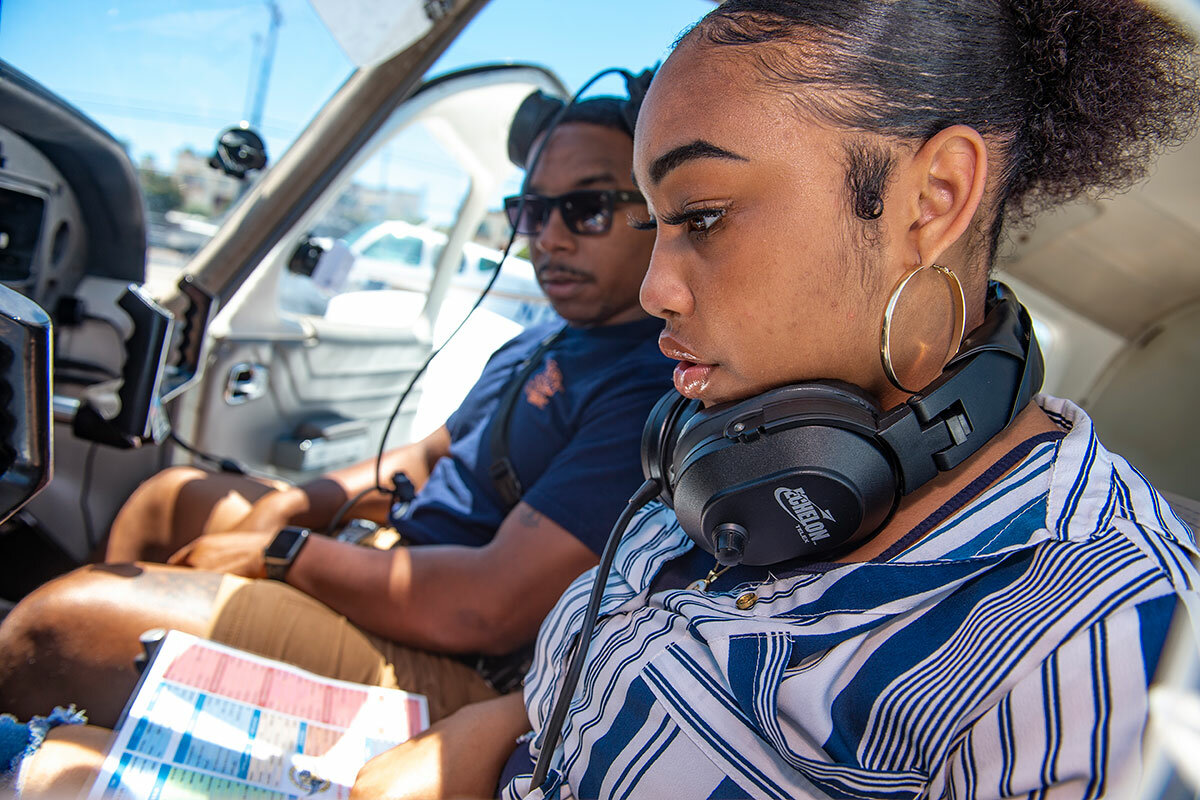At Fly Compton, the sky’s not a limit. Neither is race.
Loading...
| Compton, Calif.
As teachers and role models, the aviation professionals at Fly Compton Aero Club know the value of their Black faces to the young people who come to them to learn how to fly. Their nonprofit foundation in Los Angeles County puts Black and Latino youths at the cockpit controls and on Saturdays schools them in aerodynamics, air traffic control, and other subjects.
Major companies across the U.S. aerospace industry have launched initiatives to promote diversity, equity, and inclusion in the workforce, and Fly Compton is committed to supporting those efforts at the pipeline level.
Why We Wrote This
A story focused onIn an industry with an underrepresentation of minorities, a group of Black professionals is passing along skills to the next generation of potential aviators.
A former stockbroker, political consultant, and current president of Fly Compton, Demetrius Harris was well into adulthood before being inspired to pursue a career in aviation after boarding a flight to travel abroad.
“Both of the pilots were African American,” Mr. Harris recounts. “And I’d never seen even one African American pilot at a commercial airline before. That visual unlocked my motivation to want to become a pilot.”
“I was really nervous,” says 11-year-old Yeshaya Lang. “I don’t really like curves and stuff. Like [not even] roller coasters.”
A year ago, Yeshaya was anticipating the ups and downs of a single-engine airplane – with his own hands at the controls as a student pilot for the first time.
“I was like, ‘What if we crash?’”
Why We Wrote This
A story focused onIn an industry with an underrepresentation of minorities, a group of Black professionals is passing along skills to the next generation of potential aviators.
At Compton/Woodley Airport where Yeshaya takes flying lessons, students pilot short excursions over the neighboring city of Carson with Fly Compton Aeronautical Education Foundation, a nonprofit devoted to guiding marginalized youth into the aviation industry. It’s affordable access to professional education for careers that might otherwise be inaccessible.
But Yeshaya wasn’t thinking about his professional future as much as the Piper PA-28 Cherokee right in front of him at that moment. So he told himself, “A bunch of other kids do this a lot, and nothing’s ever happened.”
His flight went off without a hitch. So too did his second flight weeks later. On his third flight, the anxiety that had nagged at him was no more.
It’s confidence gained in an atmosphere created by professionals trying to remove some of the barriers to aviation. Across the board, the kids who enroll at Fly Compton already defy commonly held perceptions of Black and Latino youths in the United States. For Yeshaya, that means being the son of a psychologist and a Boeing executive who learned about Fly Compton through work. But as a function of systemic financial and social barriers that limit access to educational resources largely on the basis of race, these young people still commonly encounter barriers that their white counterparts do not.
“[It’s] about educational access,” says Alex Barker, Fly Compton Aero Club’s chief certified flight instructor.
While representing 12.3% of all U.S. workers 16 years and older, African Americans made up only 3.9% of U.S. aircraft pilots and flight engineers in 2021, a tiny increase over a decade ago, according to the Bureau of Labor Statistics. Labor stats for Latino, Asian American, and female pilots and flight engineers during the same periods are comparably low.
Major companies across the U.S. aerospace industry have launched initiatives to promote diversity, equity, and inclusion in the workforce – among them Delta Air Lines, United Airlines, Northrop Grumman, and Lockheed Martin. American Airlines, for one, has begun to employ graduates of its Cadet Academy – a project designed to train and lend other critical support to prospective pilots, with people of color and women as principal areas of focus.
Creating an atmosphere of support
For its part, Fly Compton is committed to supporting those initiatives at the pipeline level.
“What we’re trying to do is get all of these commercial airline companies and airplane builders to invest just a little to help diversify the industry that they, themselves, say they want to diversify,” says Demetrius Harris, Fly Compton president and executive director.
Students at Fly Compton are instructed using a curriculum similar to what they would encounter in an aviation program at a college or university. In person and via Zoom on Saturdays, over the course of nine months, Fly Compton students are instructed in subjects such as principles of flight, aerodynamics, airplane engine systems, weather, and air traffic control communications. The course costs students an annual enrollment fee of $125, plus $25 each month.
Fees at private aviation undergraduate institutions are high, explains Mr. Harris.
“The total cost to get a commercial license can range based on a number of factors, such as how often a student trains or how quickly they are able to grasp all of the concepts,” he says, noting that Fly Compton’s hourly rates to rent planes to adults for instruction are 15% to 20% lower than those offered by other flight schools in Southern California. “Our goal is to continuously fundraise from corporations and government entities to provide scholarships for training to our students to help mitigate the high costs.”
As the son of an air traffic controller growing up in Orange County, California, Mr. Barker, the flight instructor, had always been fascinated by aviation. Yet he never imagined that becoming a pilot was an attainable goal. Typically, in the U.S., pilots pursue either a military or civilian path.
But after earning a college degree in geology, working odd jobs, and starting a family of his own, he pursued his pilot’s license. After earning his ratings (which authorize pilots to fly specific types of aircraft), he elected to become a certified flight instructor. He discovered Fly Compton Aero Club, the for-profit flight school affiliated with the Fly Compton nonprofit. Upon meeting the team, he knew he had found a home.
Role modeling
A key benefit for students at Fly Compton is the opportunity to meet with Black aviation professionals – people who have succeeded in the industry, whom the students themselves might hope to one day join.
This includes people like Fly Compton advisory board member Tony Marshall, a retired U. S. airman and former prisoner of war who flew for the Air Force during the conflict in Vietnam; Fly Compton Director of Operations Ronnel Norman, a pilot for Alaska Airlines; and Jonathan Strickland, who pilots for UPS and started flying at age 12.
A former stockbroker and political consultant, Mr. Harris was well into adulthood before being inspired to pursue a career in aviation in 2018 after boarding a flight to travel abroad.
“Both of the pilots were African American,” Mr. Harris recounts. “And I’d never seen even one African American pilot at a commercial airline before. That visual unlocked my motivation to want to become a pilot. And literally three months after that, I was in flight school.”
Mr. Harris has piloted corporate jets for a number of celebrities and other high net worth individuals. But the work he does with Fly Compton is where his heart lies: “Honestly, I love it. I’ve had my experience flying jets, and it’s great. But this is more fulfilling to me. This is where I feel like I can make the most difference.”
For Yeshaya, Fly Compton was a key part of a memorable final year of elementary school packed with student council and sports activities and academic and citizenship awards. While he begins middle school with a strong knowledge of a potential career in aviation, Yeshaya says he’s uncertain about exactly what career he wants.
But when asked what he thinks about becoming a pilot, his eyes light up: “I think it would be a fun job.”











